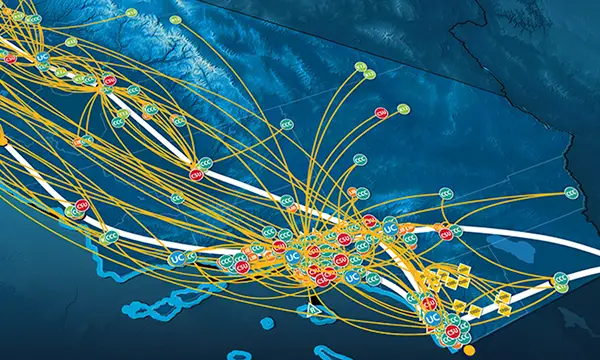- About
- Network
- Community
- Initiatives
- News
- Events
- Blog
- Publications

The Future of California’s Communications Grid
Categories RENS & NRENS
Just like water and electricity, Internet access is essential infrastructure for modern communities. To help plan for California’s communications needs, the California Public Utilities Commission (CPUC) gathered all five members for a first-of-its-kind forum in Sacramento on May 20 to hear from panels of experts on five topics. The CPUC regulates the telecommunications industry and administers public purpose programs such as the California Advanced Services Fund. In 2018, CPUC managed more than $700 million in public telecommunications programs.
“Access to the Internet is essential for health and wellbeing in today’s society,” said Commissioner Clifford Rechtschaffen. “We’ve been grappling with the fact that there are still parts of the state that don’t have access to high-quality broadband and that will continue to be an important part of our efforts. We want to make sure that these communities don’t just catch up, but that they don’t fall behind. That they get tomorrow’s technology.”
CPUC President Michael Picker posed these guiding questions: “What are the obligations that we, as regulators, have to the public in terms of overseeing service, what is the obligation providers have to the public, and how do we make sure the needs of California are met as these industries become increasingly competitive?”

Increasing Demands From Libraries and Schools
The Libraries and Education Panel focused on the demands libraries and K-12 schools will put on the communications grid as more and more digital learning occurs over the Internet. As a key provider of Internet access for many of these sites, CENIC is aware of the incredible growth in demand.
CENIC sees roughly 60% growth each year in the amount of data that passes over the California Research and Education Network (CalREN). Since May of 2018, the network will have moved an exabyte of data. CENIC President and CEO Louis Fox said, “That is 1 billion gigabytes. Just to give you a sense of magnitude, if you looked at the entire written works of humankind from the beginning of recorded history in all languages, that's 50 petabytes, which is still only 50 million gigabytes.”
Schools with a 1 or 10 Gbps connection to the CENIC network leverage technology-based learning to get students coding in kindergarten, producing stop-motion animation in third grade, and using virtual reality in high school to study anatomy. “This is going on in pockets across the state and our goal should be that it goes on everywhere,” Fox said.
About 80% of K-12 schools and about 70% of libraries are now connected to the CENIC network. More than half of K-12 schools are connected at speeds of 1 gigabit or higher. A record 673,000 students simultaneously took statewide tests over the network in May without incident. But work remains to build out access to the remaining sites, and ensure all schools are part of resilient and redundant local networks in case of emergencies or disasters.
Emergency Response, Economic Development, and Security
The Affordability and Access Panel stressed that people need more than just a smartphone and a data plan. California needs a comprehensive connectivity plan that integrates infrastructure, disaster and recovery, and economic development systems. Roughly 43% of rural Californians don’t have reliable Internet access. State lawmakers have set a goal to connect 98% of California households.
The Emergency Preparedness and Response Panel focused on the challenges for emergency communications. First responders increasingly rely on broadband for up-to-the-minute data, and ubiquitous Internet with backup paths is critical. “Nothing crystalized the need more than the past two summers of fires,” Commissioner Martha Guzman Aceves said.
The Economic Growth and Prosperity Panel highlighted the lack of broadband options in agricultural and rural areas, which prevents many businesses outside California's major cities from evolving to embrace 21st-century business models. Deployment of precision agriculture technology on farms and ranches could result in at least $47 billion in national economic benefits every year. Panelists said getting broadband to rural communities will require the construction of middle-mile fiber-optics, and the empowerment of local governments to tailor solutions for last-mile connections.
On Cybersecurity and Communications, panelists said security is expensive and many organizations are gambling that they won’t get hit. Threats continue to get more sophisticated and the number of incidents will only continue to rise.
CENIC’s Unique Position
Blair Levin, who served as chairman of the Federal Communications Commission when the Telecommunications Act of 1996 was passed, moderated the Libraries and Education Panel. “CENIC is a really important institution, and I think it’s one of the unsung heroes of Americans’ international leadership,” Levin said. “[CENIC is] engaged not just in California, but with the most advanced research institutions in the world, including a lot of private sector entities. You are one of the great enablers of California's leadership in technology. You see what the world is going to need 10 years from now better than most people because of the nature of what CENIC does.”
It is this unique position that enables CENIC’s board and leadership to extrapolate how the technology is advancing — which pilot projects are proving the tools, approaches, and methods of tomorrow. In addition, through CENIC’s wide variety of partnerships across private, public, and educational sectors as well as across its member segments, it also has a sense for where demand and growth are heading among subpopulations of the state.
Such partnerships are the vehicle through which California can close the digital divide, panelists said. CENIC maintains many private partnerships through settlement-free peering, which also enables greater efficiencies. “We hand off traffic to other large networks as they do to CENIC,” Fox said. “When we do that, we don’t have to buy commodity Internet, the network performs better, and we have caching strategies to bring content closer to users.” CENIC peers 90% of its non-research traffic, which means it only has to buy commodity Internet for 10%, which given the scale of CENIC’s network, is still a significant amount of network traffic.
Fox has noted in the past, "In terms of widespread Internet connectivity, the low-hanging fruit has been picked. To achieve a complete network mesh across the state, and thereby include all communities, private-sector technology companies will need to work more collaboratively with government and nonprofit community organizations to approach an underserved geographic region with a comprehensive strategy that stitches together fiber, fixed wireless, unlicensed spectrum, TV whitespace, and more. We can no longer deploy in a series of siloed one-off projects, if we are ever to serve some of the hardest to reach places.”
The CPUC meeting provided a baseline from which the CPUC plans to have more-targeted, follow-up workshops around each topic with stakeholders. Commissioners said they are eager to ensure the state’s goals are met. “Broadband is an essential service,” said Commissioner Genevieve Shiroma. “California has the fifth-largest gross domestic product in the world, just behind Germany and ahead of Great Britain. Technology has the ability to keep us in that position and should be leveraged.”
Watch the proceedings and submit your comments related to the meeting. CPUC posted the En Banc Hearing Summary of the discussion with public comments on July 8, 2019.
Related blog posts
The Big Game Is Big Data: How CENIC and the California Research and Education Network Support Member Athletics
When Fresno State needed to connect to Pac-12 Enterprises to broadcast a live football game over CBS, the Chancellor's Office reached out to CENIC for what Pac-12 later called the smoothest turn-up they've ever experienced.
Enabling Network-Based Collaboration Around the World: A Tour of CENIC and Partner Network Maps
On the Network Maps page at the CENIC website, you’ll find maps of all the networks, peering facilities, and exchanges to which CalREN connects, showing how thousands of CENIC member institutions connect to CalREN and to colleagues all over the globe.


